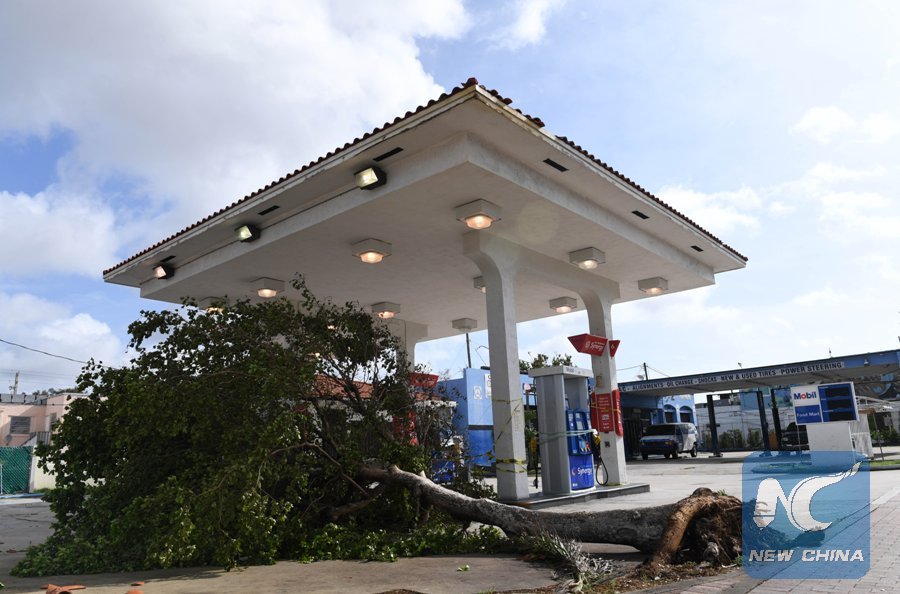
A tree is seen after being toppled by strong wind after Hurricane Irma swept through the area, in Miami, Florida, the United States, on Sept. 11, 2017. (Xinhua/Yin Bogu)
MIAMI, the United States, Sept.12 (Xinhua) -- "We felt like a big bomb on top of the roof," Hector, a homeowner in South Miami's Coconut Grove, told Xinhua Monday, as he recollected the scene from Sunday's storm.
"We were inside the house, in another room. We only realized after a while that it was a tree," he said, pointing to a section of heavy log that smashed onto the roof of his house.
"Actually that's an oak tree, and oak trees are supposed to be very hard. That tree has been there for 300 years," he said, still in disbelief over the strength of the 200 km/h wind brought by Hurricane Irma.
Coconut Grove was one of the places around Miami which took the worst hit by Hurricane Irma. At a nearby marina, boats were stacked on top of each other by the time residents returned.
Further north in downtown Miami, three crane towers were completely destroyed. In Brickell, water as deep as three feet flooded streets and homes.
Despite the heavy property losses, the hurricane has taken a less toll on the resident's mood.
By noon, Diane Thorne, a resident of Miami Beach for 24 years, was already taking her two dogs to the beach for a walk.
Thorne said Hurricane Irma was the worst storm she had experienced since moving here from Australia. "This is definitely the worst one, I've never evacuated for any other storm," she said.
But she came back to her home near the beach just one day after the storm has passed, and was ready to continue with her life, even if it meant she had to climb the stairs to her 9th floor home for the time being.
As the day wore on, fallen trees and branches started to disappear from the streets, and signal lights came back to work, replacing temporary traffic wardens that kept order at intersections.
In the famous neighborhood of Little Havana, convenience shops and bakeries reopened their boarded up windows and doors, drawing lines of hungry residents who longed for fresh food.
By late afternoon, a few gas stations were open for business, putting up price signs and striping the plastic cover that protected the pumps during the storm, and supermarkets were once again filled with customers.
As night falls, the remnant effects of the hurricane can still be felt. At around 7:00 p.m. local time (2300 GMT), police officers told businesses to close down and observe curfew that the city authorities have imposed before the hurricane hit. And for millions of homes, including Hector's, it will take days before electricity can be restored.
According to media reports, more than 7.7 million homes and businesses lost power due to Hurricane Irma, 6.7 million of which are in the state of Florida. Four in five homes in the Miami-Dade County lost power at some point during the storm.
But the loss of power was only part of the picture. Worse pains to recover from were the loss of 10 lives in the United States that were caused by Hurricane Irma.
Most of the deaths were in regions that had less time to prepare for the storm due to its last-minute turn from eastern Florida to the western coast.
One person was killed in the southwestern county of Monroe. Two people in the western Hardee county were killed after their cars crashed in the rain. Another person in the central city of Orlando was killed after being electrocuted by a downed wire.
Additional three people died in the state of Georgia.
Compared with the unfortunate, the some 6.5 million evacuated Floridians who will start returning to their homes after roads are cleared and flights resumed can count themselves fortunate.
"We are safe," Hector said as he stood before his damaged home, "That's the most important thing."

